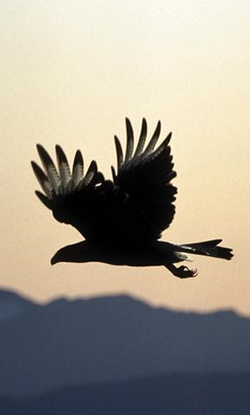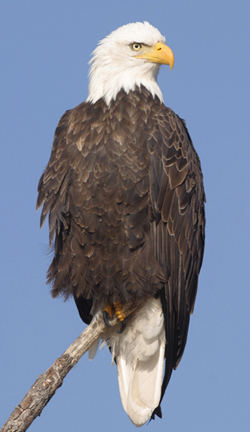Estimados amigos, a partir de hoy todos los jueves nuestro post será bilingüe. De momento estamos traduciendo los post que nuestros amigos americanos nos han pedido. Espero que los disfrutéis.
Entre las aves, el águila es la que vive más tiempo: cerca de 70 años. Pero para alcanzar esa edad debe tomar una difícil decisión: nacer de nuevo.
A los 40 años sus uñas se encogen y se ablandan, dificultándole agarrar presas con las que alimentarse. El pico alargado y puntiagudo se encorva. Las alas envejecidas y pesadas se le doblan sobre el pecho impidiéndole emprender vuelos ágiles y veloces.
 En ese momento le quedan al águila dos alternativas: morir o pasar por una dura prueba a lo largo de 150 días. Esta prueba consiste en volar a la cumbre de una montaña y buscar abrigo en un nicho cavado en la peña. Allí golpea el pico viejo contra la piedra hasta quebrarlo, y espera hasta que le crezca el nuevo. Con este pico nuevo se arranca las uñas, y cuando le vuelven a crecer, el águila se deshace de las plumas viejas. Después de cinco meses, con el plumaje renovado, arranca a volar, decidida a vivir otros 30 años.
En ese momento le quedan al águila dos alternativas: morir o pasar por una dura prueba a lo largo de 150 días. Esta prueba consiste en volar a la cumbre de una montaña y buscar abrigo en un nicho cavado en la peña. Allí golpea el pico viejo contra la piedra hasta quebrarlo, y espera hasta que le crezca el nuevo. Con este pico nuevo se arranca las uñas, y cuando le vuelven a crecer, el águila se deshace de las plumas viejas. Después de cinco meses, con el plumaje renovado, arranca a volar, decidida a vivir otros 30 años.A lo largo de la existencia, la posibilidad de sobrevivir y de no caer en la mediocridad depende muchas veces de imitar el ejemplo del águila. El que se entrega abatido al peso del sufrimiento y de las dificultades, tiende a abreviar sus días o a vivir en una rutina del sinsentido.
Muchos de nosotros, llegados los 40, hemos sentido una llamada a dejar cosas, cambiar de vida, de trabajo, de profesión. Surgió como un revuelo interior intenso que no siempre acabó como hubiéramos deseado. Nos cuestionamos la pareja cuando la crisis era profesional, o por el contrario dudamos de nuestra profesión cuando necesitábamos una “puesta a punto” de nuestra vida familiar. Para algunos, ambas, la carrera y la familia han quedado perjudicadas. Ahora, con una mirada retrospectiva nos debatimos entre el dolor y los remordimientos.
Ejercicio:
· Lee detenidamente la historia y analiza el simbolismo de la vida del águila con tu vida.
· Acepta que todo lo que has vivido hasta ahora ya no te sirve. El cambio parece inevitable. En ese momento, tu vida se está agotando, como la del águila
· Para renacer debes crear sinapsis diferentes en tu cerebro. Convertir tu manera de pensar, sentir y hacer en otro modo por completo distinta.
· Haz una lista de las cosas que están afectadas en tu vida personal y otra en la vida profesional
· Decide qué puedes cambiar y qué no, de cada una de las listas.
· Al igual que el águila debes buscar un lugar de retiro para encontrarte, y decidir cómo llevar a cabo este cambio en tu forma de vivir
· Tal como hizo el águila debes disponerte a quitarte todo aquello que no te deja renacer
· Quizá sólo necesites unas horas, hablar con un experto, es posible que un estudio de desarrollo personal… En cualquier caso, algo que te conduzca a un plan de acción a corto, medio y largo plazo
Si lo haces de este modo, el éxito en tu cruzada será total.
…………………………………………………………………………………………………………
Of all birds, the eagle is the one with the longest lifespan: around 70 years. But to reach this age, it must make a difficult decision: to be born again.
When the eagle is around 40 years old, its talons begin to shrink and soften, making it difficult to grab the prey it needs to feed itself. Its long, sharp beak becomes bent, and its old and heavy wings fold over its chest, preventing it from flying swiftly and with ease.
 At this point, the eagle is left with two options: to die or to undergo a hard test that lasts 150 days. This test requires flying to a mountaintop and taking shelter in the niche of a rock. Here, it knocks its old beak against a rock until breaking it and waits for a new one to grow. With its new beak, the eagle pulls out its talons, and when these grow again, it plucks out its old feathers. When its feathers have grown, after five months, the eagle takes flight again, determined to live another 30 years.
At this point, the eagle is left with two options: to die or to undergo a hard test that lasts 150 days. This test requires flying to a mountaintop and taking shelter in the niche of a rock. Here, it knocks its old beak against a rock until breaking it and waits for a new one to grow. With its new beak, the eagle pulls out its talons, and when these grow again, it plucks out its old feathers. When its feathers have grown, after five months, the eagle takes flight again, determined to live another 30 years.Throughout our existence, the opportunity to survive and to not stumble into the pitfall of mediocrity often depends on imitating the example of the eagle. He who gives in to the burden of suffering and hardship tends to shorten his days or to live in a meaningless routine.
When we reach our 40s, many of us feel the need to leave things behind, to change our lives, jobs, professions. This need emerges like a strong internal urge that does not always end as we would have liked. We question our partner when the crisis is professional or, on the contrary, have doubts about our career when what we need is to «fine tune» our family life. For some, both career and family suffer. Now, with a retrospective look at the past, we are seized by pain and remorse.
Exercise:
· Read the story carefully and analyse the symbolism between the eagle’s life and your own.
· Accept that everything you have experienced up to now is no longer of any use. Change seems inevitable. At this moment, your life is seeping away, like the eagle’s.
· To be born again, you must create new synapse in your brain. Radically change your way of thinking, feeling and doing.
· Make a list of the things that are affected in your private life and another for your professional life.
· Decide what you can and can’t change in each list.
· Like the eagle, you must find a retreat in which to find yourself and to decide how to make this change in your way of living.
· Just like the eagle, you must be willing to rid yourself of everything that prevents you from being born again.
· Maybe you only need a few hours, to talk to an expert, to do a personal development study, perhaps… in any event, do whatever it takes to come up with a short, medium and long-term action plan.
If you do it in this way, your crusade will be truly successful.


 0
0
No hay comentarios